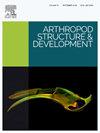Sensilla on the maxillary palp of cave and surface-dwelling species of the genus Tachycines (Orthoptera: Rhaphidophoridae)
IF 1.3
3区 农林科学
Q2 ENTOMOLOGY
引用次数: 0
Abstract
Due to caves' environmental features (e.g., darkness and food limitation), cave-dwelling insects have evolved well-developed sensory systems. The habitats of the camel crickets of Tachycines are diverse, found both in cave and surface ecosystems. This study aims to clarify the sensilla types and distribution on the maxillary palp in male adults of the surface-dwelling Tachycines huaxi and cave-dwelling Tachycines shuangcha. The morphology and sensilla on the maxillary palp were observed using scanning electron microscopy. The maxillary palps of the two Tachycines species consist of five segments with varying lengths. Seven types of sensilla were recorded on maxillary palp of both species: sensilla chaetica (Sc.1–3), sensilla trichodea (St.1–2), sensilla palmatum (Sp), Böhm's bristles (Bb), sensilla campaniformia (Sca), sensilla basiconica (Sb.1–4), and sensilla coeloconica (Sco). The sensilla are primarily located on the fifth palpomere ofmaxillary palp. Sb.2 were found exclusively on maxillary palp of the species T. huaxi. The distribution of sensilla was similar between T. shuangcha and T. huaxi, but sensilla of the two species differed in length, diameter, and number. The potential functions of these sensilla, and possible morphological adaptations to the cave environments exhibited by the maxillary palp of the cavernicolous T. shuangcha are discussed.

穴居和地表生活的刺蝇属种上颌触须上的感受器(直翅目:刺蝇科)
由于洞穴的环境特征(如黑暗和食物限制),穴居昆虫进化出了发达的感觉系统。塔奇辛骆驼蟋蟀的栖息地多种多样,既有洞穴,也有地表生态系统。本研究旨在厘清华西和双茶两种地表栖大锥虫雄性成虫上颌触须上的感受器类型和分布。用扫描电镜观察上颌触须的形态和感觉器官。上颌触须由五个不同长度的节组成。两种上颌触须均有7种类型的感受器,分别为:chaetica感器(s1 - 3)、trichodea感器(s1 - 2)、palmatum感器(Sp)、Böhm的刚毛(Bb)、campaniformia感器(Sca)、basiconica感器(s1 - 4)和coeloconica感器(Sco)。感受器主要位于上颌触须的第五触须上。sb2只存在于桦尺蠖的上颌触须上。双茶和花溪的感受器分布相似,但在长度、直径和数量上存在差异。讨论了这些感受器的潜在功能,以及双茶上颌触须对洞穴环境可能表现出的形态适应。
本文章由计算机程序翻译,如有差异,请以英文原文为准。
求助全文
约1分钟内获得全文
求助全文
来源期刊
CiteScore
3.50
自引率
10.00%
发文量
54
审稿时长
60 days
期刊介绍:
Arthropod Structure & Development is a Journal of Arthropod Structural Biology, Development, and Functional Morphology; it considers manuscripts that deal with micro- and neuroanatomy, development, biomechanics, organogenesis in particular under comparative and evolutionary aspects but not merely taxonomic papers. The aim of the journal is to publish papers in the areas of functional and comparative anatomy and development, with an emphasis on the role of cellular organization in organ function. The journal will also publish papers on organogenisis, embryonic and postembryonic development, and organ or tissue regeneration and repair. Manuscripts dealing with comparative and evolutionary aspects of microanatomy and development are encouraged.

 求助内容:
求助内容: 应助结果提醒方式:
应助结果提醒方式:


